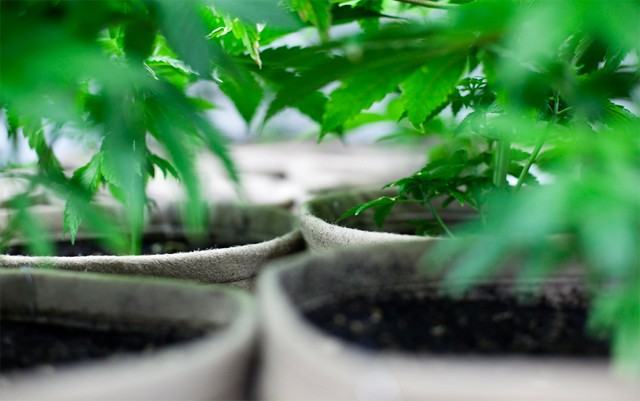If you’re anything like me when I was starting out, you might feel a little lost trying to decide what type of light to use in your marijuana garden. That’s what I want to help you with today. I won’t be going in depth on details like lumens, spectrums, wavelengths, etc. I’m simply going to go over the 3 types of lights you’re likely considering, and give you advice and recommendations for each that will help you decide which is best suited for your needs.
Incandescent
Let’s start with the type of lighting that you would do well to avoid using.
Incandescent bulbs are the run of the mill light bulbs that are commonly found in households. If you frequent the different cannabis cultivation forums, you’ll undoubtedly see that a common question is, “Can I use regular incandescent bulbs in my grow?” For the most part the answer to this question is a resounding “no”. Why?
While these types of bulbs do emit some of the frequencies of light a marijuana plant can use, it’s a very small amount. A large percentage of the light it emits is just too far into the red and infrared spectrum. This type of light causes your plant to grow internodes that have a huge amount of spacing between them. Put simply? Your plant will concentrate its growth on the length of the stem. At the end of the day you’ll be left with several inches of lanky stem topped with a few leaves. Eventually your plant will just topple over. Yes, it is as sad looking as you would think.
Some other downsides of using incandescent bulbs are that they generate extremely poor vegetative growth and yield. Assuming you even get that far, of course. But the main concern, and I’ll highlight this a few more times throughout my post, is safety. To be blunt about it, these types of bulbs just get too damn hot. Be smart guys, please don’t toy around with fire hazards.
Fluorescent
Alright, so I see a lot of growers knocking fluorescent lighting. This is mostly because fluorescent lights aren’t going to give you monster sized plants. But you know what? Don’t let that deter you! Maybe you aren’t looking to grow oak trees; you just want enough to keep your stash filled. Perhaps you’re on a tight budget and a HID system is out of reach. Or you could be a total newbie to all of this cultivation business and you just want to keep it simple for now.
Whatever your reason(s) are, there is no shame in growing marijuana with fluorescent lights. For one, you can, in fact, grow some pretty prolific plants with these types of lights. But also, it’s your grow! Do it however you please and ignore the haters and naysayers. I promise you, if you dial in the rest of your grow (nutrients, temperature, water, etc) you can have a harvest worth smiling about.
Now that my rant is over, let’s get into fluorescent lighting a little bit more, shall we?
What kind of fluorescent bulbs should you use? Well, you have a few options to choose from: fluorescent tubes (like the kind in an office or shop light), compact fluorescent bulbs (commonly referred to as CFLs), and my personal favorite, T5 lamps.
The downside to fluorescent tubes is that the light they emit isn’t very concentrated due to it being spread over a wide area. Considering this, and the fact that the intensity of the light they produce is fairly low, they aren’t an ideal choice. It’s safe to say that you shouldn’t expect large, dense buds come harvest time. Besides, a cheaper and more efficient option would be to use CFLs.
For those of you that don’t know, CFLs are those fluorescent bulbs shaped in a spiral like form. The lumen output on these isn’t great but because of their size, you can really pack them into your grow space. I’ve seen some pretty incredible plants that were grown solely using CFLs. So don’t let anyone tell you that you’re wasting your time with them. The trick is to get creative and figure out how to fit as many bulbs in your space as possible, within reason, of course.
If your concerns with lighting your garden aren’t cost related, but instead center around space and not being able to efficiently cool a large lamp, I would seriously consider a T5 lighting system. T5’s are simply just high output fluorescent lights; meaning they emit a much more intense light than a standard fluorescent bulb. The downside to these, as I alluded to, is the cost. Depending on the brand and size that you go with, they can cost more than an HID system. But they are well worth it if you have limitations that require you to grow with fluorescent lighting as opposed to HID.
Before we move on, I want to give you a bit of advice for growing with fluorescent light:
- Fluorescent lights don’t get very hot at all. Get them as close to your plants as possible. This will help compensate for the lack of intensity and penetration.
- Even so, use a fan. You shouldn’t need anything too big, just a small clip fan should suffice.
- Use 6500K bulbs during veg and for flower use 2700K (3000K works too). With that being said, your best bet is to use a combination of both. Adjust the ratio of bulbs relative to the stage of growth you are in.
- If you’re using a T5 system, add in some CFLs wherever there is space. In fact, when growing with fluorescent lighting, if you can safely add more, do it!
High Intensity Discharge
High Intensity Discharge lights (HIDs) are great for growing marijuana, obviously. There’s two different kinds: Metal Halide (MH) and High Pressure Sodium (HPS). Light emitted from an MH is in the blue spectrum, which makes it ideal for vegetative growth, while an HPS produces light in the red spectrum, which makes it ideal for flowering. If you have to choose one type to use through the entire grow, I would go with an HPS. Fortunately though, most HID systems allow for the use of both MH and HPS bulbs and even come with one of each.
There are some things you need to consider before investing in this kind of setup though. The most significant of which is the heat. If you think you can just install one of these bad boys without some serious ventilation, you’re wrong. Invest in a strong centrifugal fan and save yourself a world of frustration.
What size of light do you need? There are 3 popular wattages: 400W, 600W, and 1000W. Naturally, each light is somewhat limited to a particular footprint.
- 400W 3 ft x 3 ft
- 600W 4 ft x 4 ft
- 1000W 5 ft x 5 ft
Bear in mind that these numbers represent the square footage each light will efficiently cover. You can use a 400W light in a 4 x 4 space, but the intensity of the light reaching gradually weakens past 3 x 3 of canopy. Conversely, you can also use a 600W light in a 3 x 3 space if you can keep the temperature in check.
Lastly, you need to consider the amount of vertical space you have available in your garden. Unlike fluorescents, you can’t put an HID light right on top of your plants. They just put off too much heat. You need between 1 and 2 feet of space between the tops of your plants and your light. Stop and really put some thought into this guys. Let’s say you have tent that stands at 5 feet. Are you sure you can keep your plants under 3 feet? What are you going to do if you can’t?
I can’t tell you enough how much stress can avoided when using HIDs simply by planning your grow ahead of time.
Conclusion
Alright let’s summarize, yeah?
Don’t use incandescent lights. Put simply, they have little to no place in your garden. It’s okay that you didn’t know this, I didn’t either when I was planning my first grow.
Fluorescents are great if they suit your needs. Despite what you may read in some forums or magazines, you aren’t necessarily better off going with a HID system. Be realistic about what you’re trying to achieve and then get creative on how you’re going to maximize the amount of light your plants are getting. If you have the money, invest in a T5 setup. If you’re on a tight budget and can’t afford to go the T5 route, go with CFLs over the regular fluorescent tubes.
Regardless of the type of fluorescent lights you choose, use a combination of 6500K and 2700K; adjusting the ratio according the stage of growth your plants are in.
If you and your space can handle it, take the leap and get yourself a quality HID system. It’s okay to use just an MH bulb or just an HPS bulb throughout the entire grow. More than likely though, you’ll be able to find an MH/HPS combo. If for some reason you can’t, reach out to me and I’ll point you in the right direction. Use your MH bulb for veg and your HPS bulb for flower. It’s extremely important that you plan ahead before buying an HID light setup. Stop and ask yourself, “Can I ventilate my grow space enough to keep the temperature in check? Do I have enough space for this kind of light?” I would recommend overestimating your needs when it comes to using HID lights. Need 5 feet of vertical growing space? Make sure you have 6 feet. Got your ventilation squared away? Find ways to improve it.
Listen, the most important thing for you do when choosing a light is to be safe and smart. Be realistic about what your space can handle and avoid creating a fire hazard. Your home and life is never, and will never be, worth growing marijuana. After that, be honest about what your looking to achieve and plan according to those goals. You can always upgrade your setup later on down the road.
As always, if you have questions or want to dig deeper into this subject, get at me in the comments!







Nothing about LED’s?? I appreciate you writing this, but no offense its rather incomplete without including LED’s in this comparison. LED’s have come a long way. Expensive yes, for high end equipment, but the costs offset down the road with energy savings. Just a thought.
How can you possibly talk about the right grow lights and not talk about LEDs? This is why I don’t normally read this website – it’s “cannabis lite” compared to Dope.